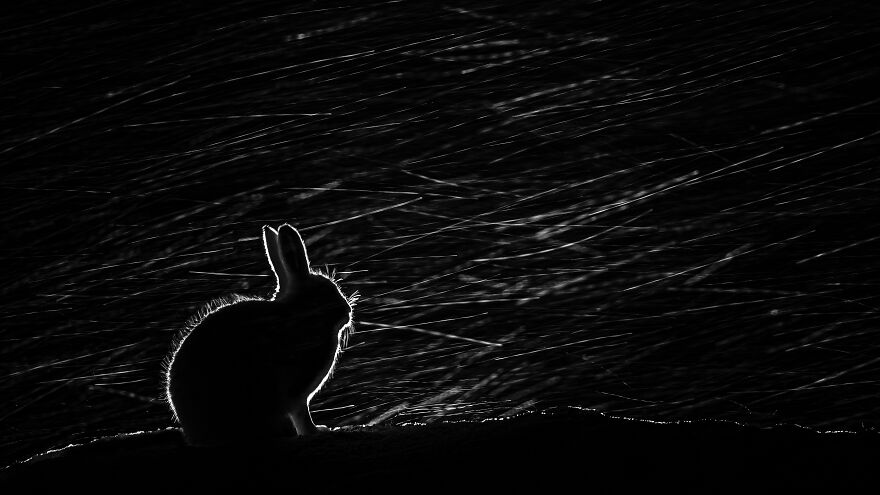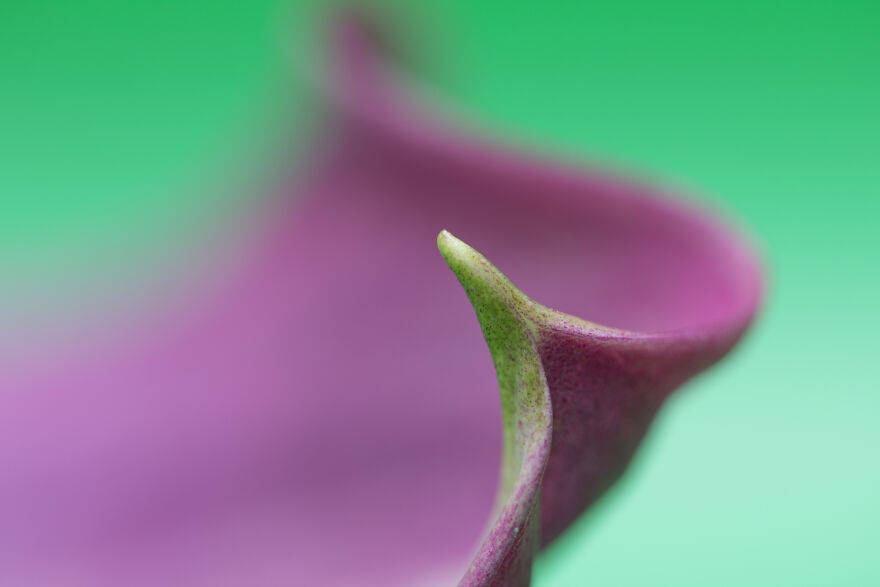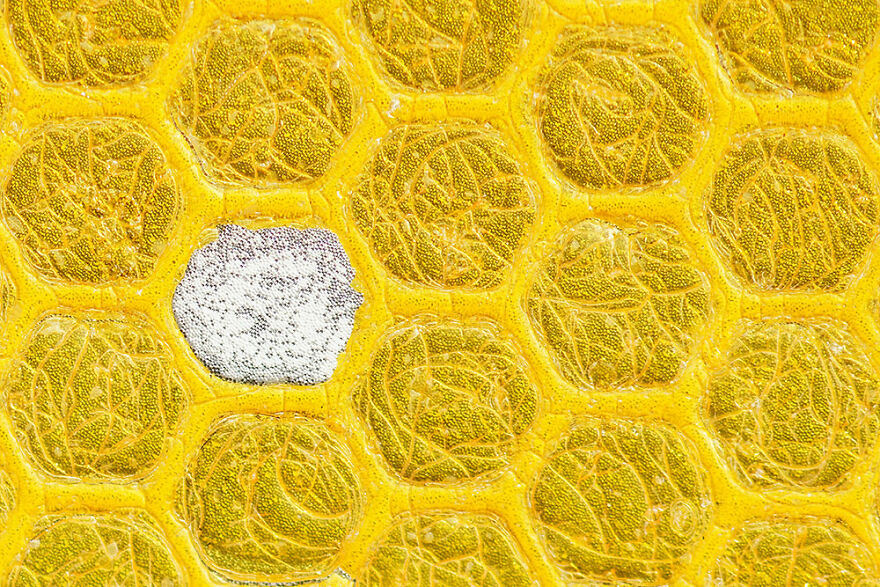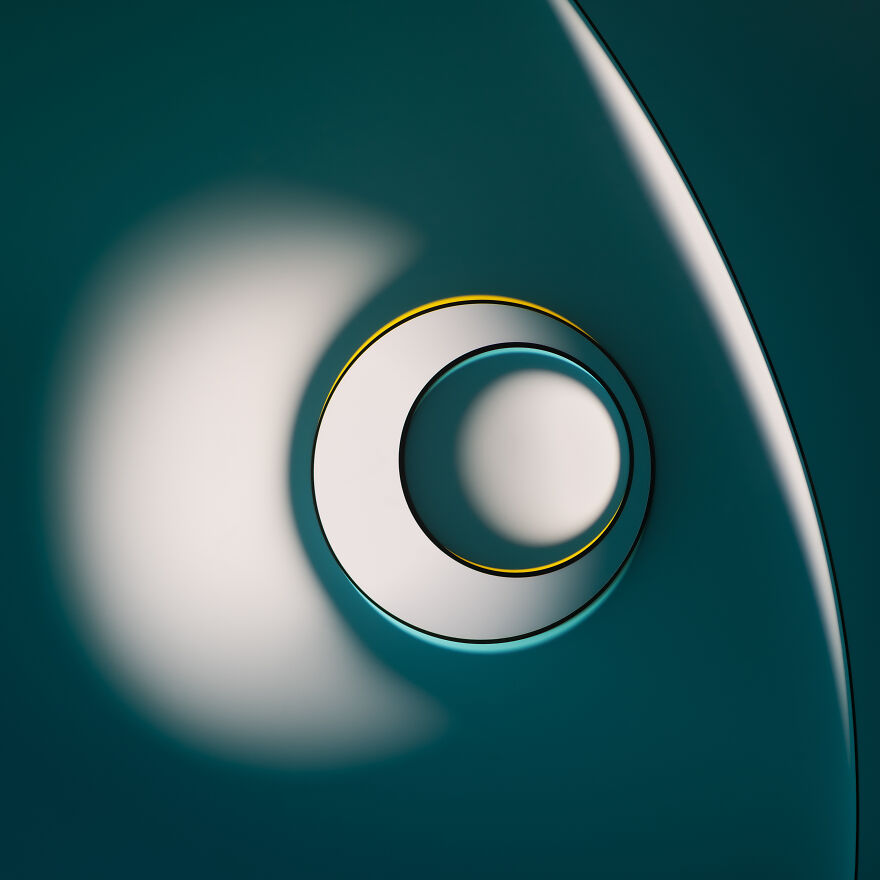This extraordinary collection showcases the crème de la crème of the 2022 challenge, where talented photographers from around the globe demonstrated their exceptional skills in capturing the essence of minimalism in close-up shots.
Each winning photograph is a testament to the artists’ keen eye for detail, composition, and the ability to transform simplicity into captivating visual narratives. Prepare to be mesmerized as you explore these remarkable masterpieces, each a testament to the power of minimalism in photography and the talent of its creators.
1st Place: “In Her Wedding Dress” By Ferenc Kocsis

“This female Danube mayfly, swollen with egg clusters, flies over the Danube River in Hungary and lays its eggs close to where it was born. The larvae that live in the riverbed hatch in April, and in the last stage of their development, in August, they fly for the last dance of their one-year life.”
2nd Place: “Colour Study 39” By Paul Gravett

“Despite their painterly appearances, each Colour Study starts with a camera and a series of photographs of papers and colour acetates, layered three to five deep on a stack of glass shelves. The images are layered and blended in the computer to create abstractions that reference contemporary art, including pointillism, colour fields, transparencies, collage and painterly techniques. The hallmark of this experimental process is unpredictability and discovery, leading to startling and unexpected images that blur the boundary of photography and contemporary art, tricking the eye and testing our assumptions about photography.”
3rd Place: “Goose Bumps” By Stefan Gerrits

“In Varanger, Norway, a mountain hare (Lepus timidus) sits quietly in a snowstorm very close to midnight. It was a rough winter evening in the very far north of Norway, I was sitting down, and my goodness I was cold, chilled to the bone, waiting for signs of life. Thankfully, I got lucky. This hare seemed to have some form of piloerection (the equivalent of human goosebumps), which made its hair stand on end. I underexposed by 4EV and used a slow shutter speed (1/13sec) to transform the snow into flashes of light.”
Finalist: “Details Of A Rough Stink Bug” By Benjamin Salb

“I love finding hidden details within ordinary macro subjects and this rough stink bug was no exception. I encountered it while on a 4am macro hunt last autumn. It was a chilly morning and the few subjects I did find didn’t move that much, if at all. As a result, I was able to position the stick the stink bug was sitting on in the air to isolate it from the background and show off its complex details. The image was captured as a handheld focus bracket of 17 frames (combined in Helicon Focus).”
Finalist: “Murky Waters” By Lovre Culina

“This bird’s-eye view of an American crocodile was made over the Tarcoles River of Costa Rica, from a bridge. A picture like this had been in my mind’s eye for a while and, as I knew the area well, I had hoped to find a crocodile positioned perfectly in the water just under the bridge. Unfortunately, the dream composition wasn’t to be, and I had to stretch my arms out, get a shot and crop and rotate it later to get the picture I wanted. Crocodiles are ambush predators and spend most of their time being still and waiting. My aim was to depict this incredible marvel of nature in its element, while leaving the viewer slightly unsure about what is being shown.”
Shortlisted: “Gills” By Jeannet Van Der Knijff

“Last October I found this parasol mushroom during a walk in the ‘Staelduinse bos’ in ‘s Gravenzande, Netherlands. The fungus was broken, so the gills on the underside of the fungus were clearly visible. The wavy interplay of lines of the gills produced a very beautiful pattern. On one of the gills I noticed a small black dot moving. When I got home, I saw on my screen that the black dot had legs: it was a mite. With a size of less than 0.1 to 1.0 mm, these small arthropods are barely visible to the naked eye. Because of the presence of the mite on the gills, the image reminds me more of a huge maze than of the underside of a mushroom.”
Finalist: “Shell” By Kristina Zvinakeviciute

“Shells are like little secrets of the sea. I always collect them on the seashore and this one was found on Formby Beach in the UK. I had an idea to develop the photograph of this small shell in a different way, by using the mirror effect in Photoshop (I cropped, rotated and adjusted the shot in Photoshop before using the mirror effect. A texture was then added to the background.) The result pleasantly surprised me, as it looked like wings or a heart.”
Finalist: “Stand By” By Krisztina Mácsai

“I was walking with co-students of my photography class in the forests of Normafa, Budapest, looking for interesting macro subjects. It was autumn and the forest was full of Cyclosa spiders. I searched to find one of these orb-weavers that would allow me to photograph it at this unusual angle. I had to be very careful not to harm its web. At the time the picture was taken, I was between macro lenses, so I had to return to my tried and tested combination: the “nifty-50” with extension tubes. Once again, this set up did not disappoint me.”
Finalist: “Outer Space” By Alex Pansier

“This is not Earth from outer space, but the swirling body of an elephant seal. A few years ago, I went on a photo tour to Antarctica with a stopover in South Georgia. The beaches were teeming with fur seals and elephant seals. This particular one was so relaxed I managed to photograph it quietly with some nice backlight in low key – my favourite style.”
Finalist: “Spider” By Gabi Swart

“A spider had spun its web right in front of our attic window, allowing me to photograph it against the sky. Due to overexposing by one f-stop, it appeared almost plastic and transparent. The open aperture and the overexposure made the spider’s web disappear.”
Finalist: “Lily Tip” By Jane Van Bostelen

“I love the beautiful trumpet-shape of the Calla Lily and wanted to create a minimal, uncluttered image with simple lines. After shooting from different angles, I found the strongest composition to be one where the tip of the petal was in focus and the rest was thrown out of focus using a shallow depth of field. I used a studio lightbox with LED lighting and a green background so that the shapes looked strong, and the colours complemented each other.”
Shortlisted: “Ice Droplet” By Morey Gers

“This image was made on a freezing winter day in St. Louis, MO, USA, while looking for interesting ice drops on a magnolia tree in my back yard. This ice drop, showing the internal crystal formations, is only around a ¼ inch long.”
Shortlisted: “Behind Blue Eyes” By Clement Boyer

“This Damselfly was photographed in the wild at Saint Peyronis, south-west France just after 7 am in late July.”
Shortlisted: “Four Comatrichia Nigra” By Andy Sands

“I found this line of four Comatrichia nigra slime moulds among several other groups on the underside of a fallen Beech branch in local woodland. It was late November and had been fairly wet so most of the underside had been covered in a white mould that I felt added to the minimal effect and colour palette. I photographed them with my Olympus OM1 camera and 60mm Macro lens plus 2 extension tubes, focus stacked from 56 images. Lighting was natural and with a clear blue sky and no leaves the reflections were very attractive. The background is just the carpet of fallen Beech leaves beyond. They were quite small, the largest around 2mm tall.”
Shortlisted: “Marpissa Radiata” By Adrian Truchta

“This jumping spider was living in a rolled leaf near a pond. Like every jumping spider this one has huge eyes, but in this case they were an unusual blue colour.”
Shortlisted: “A Ray Of Light” By Jose Luis Gigirey

“I found this small pair of Mycena sp. in a forest near my home in Covas, Ames, Spain. To isolate them from the forest environment, I shaded them with some diffusers and used a small piece of black cardboard to reflect the sunlight in order to capture that ray of sun.”
Shortlisted: “Mosaic Tile” By Viola Ricci

“This image of a damselfly’s wings was captured in my garden in the Po Valley, Italy, in late summer. I had noticed something unusual going on among the oak trees that day: an elegant, shimmering flutter of wings through the air caught my eye and invited me to look up close. What I did not expect to find was a group of willow emerald damselflies effortlessly catching mosquitoes while flying around and then, once landed on the lower twigs, slowly consuming their “snacks”. Observing them during their rest, I was immediately struck by the radiant orange pterostigma standing out on the transparent wings.”
Shortlisted: “Contrarian” By Ann Newman

“While looking for yellow in aspen fall foliage in the Sierra Mountains of California, I was instead brought to a stop (not literally) by a guardrail along the road. Looking more closely, the yellow hexagons and their beehive-like compositions caught my interest, especially as each cell had a unique pattern. I’m certain the few drivers that drove past thought I was unhinged.”
Shortlisted: “Oil On Water 8” By Martin Parratt

“This image is an example from my ongoing photographic exploration of the refractive effects of oil floating on water. The project is inexpensive and eco-friendly, requiring no travel and using tiny amounts of simple materials, in keeping with the minimalist ethos. Controlling the oil can be frustrating but fun – it takes some skill and patience. The shapes and arrangement were physically real and are not digitally created. Removal of blemishes in post-processing gave the refined aesthetic.”
Shortlisted: “21 Grams” By Chris Manfield

“Since its invention, photography has been used alongside scientific protocols as a tool to document and quantify truth. This photograph was taken in a biological laboratory where dead animals are preserved and studied. When we look at the photograph, we are looking at a process. We think of how the pictured subject ended up in front of the camera, why, and for what purpose? The subject has been sourced ethically, and each specimen is noted whether to have died of natural causes, purchased (dead) from a shelter, farm, or a licensed taxidermist. Still… it raises the question of ethics – whether truth is validated through documentations, real-life consensus, or perhaps something else entirely.”
Source: cupoty.com | Instagram | Facebook | twitter.com
 Barnorama All Fun In The Barn
Barnorama All Fun In The Barn